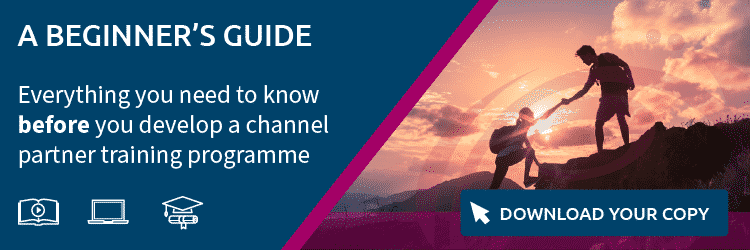Today’s business climate is more competitive than ever. Many businesses struggle to meet sales goals on their own. With revenue to generate, brand images to craft and leads to track, selling through channel partners or third-party vendors can be a time-saving solution to delivering your product or service to customers on a much larger scale. But, with competition rising, getting your channel partner relationship management right is crucial.
As much as most partners can and do have an incredibly positive impact, if the relationship between a channel partner and your business isn’t successful, the experience can cost valuable time and money.
This is where channel partner relationship management (PRM) comes in. By focusing on PRM, your business will reap the full potential of your channel partners by strengthening those connections, reducing complexity, and achieving the revenue goals your stakeholders want.
What is Partner Relationship Management?
Partner Relationship Management (PRM) is a strategy and set of technology-enabled processes for managing and optimising interactions with indirect sales channels and partners, such as resellers, referral providers, distributors, and other third-party entities.
The goal of PRM is to increase revenue and profitability by improving partner performance and ensuring strong, effective communication and collaboration between the company and its partners.
Customers and buyers will likely be drawn to salespeople who are confident and self-assured in what they’re talking about, which comes naturally with well-executed partner relationship management. Particularly with products and services on the technical side, channel partners are expected to be experts on the subject area so they can connect with customers and pitch enthusiastically and excitedly.
Not only will this appeal to your end-users, but it will also breed self-confidence in your partners and establish a deeper level of trust and gratitude.
What are the Fundamentals of Partner Relationship Management?
We’ve compiled a list of six key strategies to equip you with all the tools you need to boost your channel partner relationship management to the next level.
1. Partner Empowerment
The best way to empower your partners is to tap into their unique strengths. Each partner relationship will be different as partners will have individual qualities that they can utilise to harness an optimum outcome. Focusing on their strengths will allow you to get better results and empower and uplift your partners as they will be doing what they do best.
Find out how your channel partners communicate, their operations, and how they present themselves, identify their weaknesses (as well as their strengths) and learn their internal business processes so you can better understand how to channel your energy into enhancing them, thereby better aligning your mutual business goals.
Choosing the right partner is also an integral part of this. Your relationship can only really bloom if you have shared ambitions. Make sure you carefully consider and communicate your business goals when selecting the type of partner you want.
2. Partner Support
Support is a crucial aspect of Partner Relationship Management (PRM) and plays a vital role in ensuring the success of the partner channel. Providing effective sales and technical support to partners can help them sell and support products and services more effectively, leading to increased revenue, improved customer satisfaction, and greater success for both the company and its partners.
Offering support in the form of tools, resources, training, and ongoing guidance can also help to build strong and productive relationships with partners, which is essential for long-term success in PRM.
It’s important to provide a fast, flexible response to partners. Many businesses plan and launch a partner program that promises to deliver the necessary support, only to lose momentum along the way.
Ensuring you maintain a prolonged commitment to the program as it progresses allows for long-lasting channel partner relationships, meaning your sales will only continue to rise over time.
3. Partner Enablement
A long-term partnership that delivers value requires adding value to it first, dedicating the right level of time, money and resources to building profitable, enduring partnerships. A study from technology consulting service the Aberdeen Group showed that properly implemented platforms and processes that support channel partners result in 13% more sales reps achieving their quotas and 28% shorter sales cycles.
This is also an important factor in preventing partner churn, which can impact the time it takes to build up momentum with generating sales. Suitable partner enablement software can streamline the selling process by establishing connections between partners and the resources they require all in one place, rather than through multiple avenues such as phone calls, emails, and websites.
By providing partners with easily accessible resources, they will be more equipped and prepared to represent your company, making for a mutually beneficial relationship.
4. Training
One of the most important tips for successful partner relationship management: provide proper training. Not only will this enable partners to bring value to your end-users, but it will also help partners to keep up with the employee churn by offering on-demand online training to help them within their roles.
Training offers a constant touch-point and an additional communication channel, which is an invaluable tool for supporting partners. These systems and tools help to engage partners, providing a great solution for generating sales and boosting revenue.
Creating the right platform is crucial to streamlining the training process for you and your partners. Outsourcing this solution can be a great way to ensure the training program runs smoothly and your partners receive the right level of support.
Training directly affects PRM – without suitable training, your channel partners won’t be able to properly execute their work. Channel partner training provides:
Trust
Trust is a crucial part of any relationship, and vendors have to put in a large amount of trust in partners to be sure their brand is represented correctly. By providing training, you’re crafting a fast-track route to securing this loyalty and building a better relationship.
Faster onboarding and sales
The faster you can supply the necessary training to distributors and resellers, the quicker they can start selling your product or service.
Unified business objectives
Training provides clarity – detailing your success metrics and incentives through training means sharing the vision for the company, defining your business goals, and mapping out the driving forces behind your brand. This allows partners to align their business objectives with their suppliers.
With formalised training, time and care, your partner relationship management will strengthen your existing relationships and pave the way for future partners to become entirely immersed in your brand.
Related reading: How training benefits your partner program
5. Incentives and Rewards
Incentives and rewards provide a way to motivate partners and recognise partner performance.
Offering incentives and rewards can increase partner engagement and drive their motivation to sell and support products and services. This can help to drive revenue growth and improve the overall performance of the partner channel.
There are several ways to incentivise and reward, including deal registration bonuses, performance-based incentives, referral bonuses, and non-monetary rewards such as recognition, training opportunities, and access to exclusive resources.
It’s important to design incentives and rewards programs that align with your objectives and the needs and goals of your partners.
When incentives and rewards are well-designed and effectively communicated, they can help to build strong and productive relationships between the company and its partners, which is essential for long-term success in PRM.
6. Tracking and Evaluation
Tracking and evaluation provide visibility into partner performance and enable businesses to make data-driven decisions.
From the vendor’s perspective, tracking and evaluation can provide insights into which channel partners are generating the most revenue, which need additional support, and which are high-performing and deserve recognition. This information can inform strategic decisions about resource allocation and support for specific partners.
On the partner side, tracking and evaluation can provide transparency into their performance and help them understand how improvements can be made. This can help build trust and credibility between both parties and can drive better results.
Regular performance tracking and evaluation also provide an opportunity for continuous improvement and helps to keep the PRM program aligned with the evolving needs of the business and its partners.
Summary
By following these fundamentals, you can develop strong and productive relationships with your partners and drive greater success for both your business and your partners.
When your partner relationships are booming and your partners work well with you, end-users will see an integrated, effective team dedicated to delivering their needs.
Ultimately, successful partner relationships are the cornerstone of a prosperous business. But, relationships can only really boom with the right support and education. The more energy you put into making this the focus, the more your channel partners will be able to drive your business forward.
Are you eager to take your partner training program to the next level? Check out our latest blog post ‘8 Ways to Create Effective Channel Partner Training‘, to discover practical tips and strategies for designing and implementing successful training programs. Read it now and learn how to create effective training programs that will boost your partner relationships and drive success.











